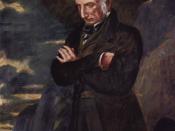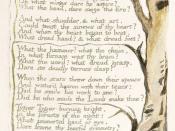In the poem's "Ode, Intimations of Immortality" by William Wordsworth and "The Tyger" and "The Chimney Sweeper" by William Blake from Songs of Experience, the poets use light and dark imagery to give the audience a picture of life and, ultimately, death. The poems all have the idea of death in common but most importantly, both poets are able to enhance the reader's experience by providing them with a real sense of place and emotion through their use of imagery. Not only do the authors interpret their senses into light versus darkness, they also use imagery of both to provide us with a way to comprehend the themes of life and death. All three poems have a common theme of how one's memory can affect the way they perceive death and the afterlife. The use of light and dark imagery in all three poems are similar because they give a firm grasping of reminiscence, enlist the aid of light and dark imagery to show us death, and give the readers a clear vision of the place the author is trying to describe.
In all three of the selected poems there is a common thread wove amongst them of how a person thinks about the afterlife and in particular, heaven. In "Ode, Intimations on Immortality" Wordsworth writes, "Forebode not any severing of our loves! / Yet in my heart of hearts I feel your might" (Wordsworth XI, 2-3). In these lines and the ones that follow Wordsworth gives us a clear picture of what heaven is to him. It is a severing of one's delights and loves, and "another race (that) hath been" (Wordsworth XI, 13). For William Blake, the idea of heaven is less subtle as he deals with it in a darker way. In...


